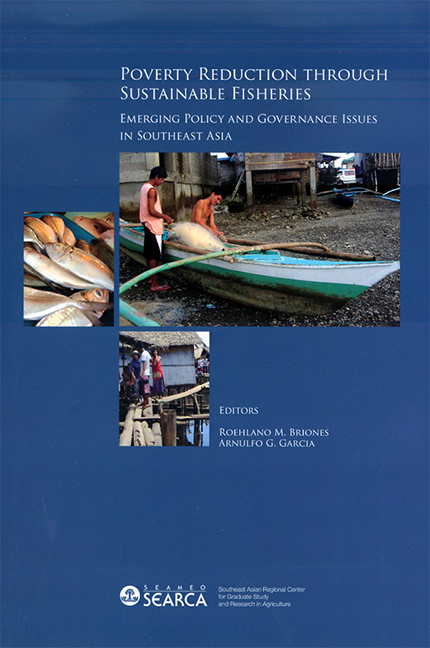 Poverty Reduction through Sustainable Fisheries
Poverty Reduction through Sustainable Fisheries Book contents
- Frontmatter
- Contents
- Figures
- Tables
- Foreword
- Acknowledgments
- 1 Introduction and Synthesis
- 2 Fish and the Poor
- 3 Fish and the Poor: The Case of Cambodia
- 4 Changing Demand and Supply Structure of Fish in Asia: Past Trends and Future Projections
- 5 Regional Economic Integration of the Fisheries Sector in ASEAN Countries
- 6 Technology Policies for Capture Fisheries and Aquaculture in Southeast Asia
- 7 The Status, Current Trends and Future Directions for Production and Technology of Fisheries in Southeast Asia
- 8 The Seafood Supply Chain and Poverty Reduction
- 9 Strategy for the Empowerment of Aquaculture Fish Farmers in Indonesia
- 10 Status of Coastal and Marine Resources: Implications for Fisheries Management and Poverty in Southeast Asia
- 11 Property Rights and Institutional Arrangements in Southeast Asian Fisheries
- 12 Regional Cooperation in Aquatic Resource Management for Southeast Asia
12 - Regional Cooperation in Aquatic Resource Management for Southeast Asia
Published online by Cambridge University Press: 21 October 2015
- Frontmatter
- Contents
- Figures
- Tables
- Foreword
- Acknowledgments
- 1 Introduction and Synthesis
- 2 Fish and the Poor
- 3 Fish and the Poor: The Case of Cambodia
- 4 Changing Demand and Supply Structure of Fish in Asia: Past Trends and Future Projections
- 5 Regional Economic Integration of the Fisheries Sector in ASEAN Countries
- 6 Technology Policies for Capture Fisheries and Aquaculture in Southeast Asia
- 7 The Status, Current Trends and Future Directions for Production and Technology of Fisheries in Southeast Asia
- 8 The Seafood Supply Chain and Poverty Reduction
- 9 Strategy for the Empowerment of Aquaculture Fish Farmers in Indonesia
- 10 Status of Coastal and Marine Resources: Implications for Fisheries Management and Poverty in Southeast Asia
- 11 Property Rights and Institutional Arrangements in Southeast Asian Fisheries
- 12 Regional Cooperation in Aquatic Resource Management for Southeast Asia
Summary
ABSTRACT
The ecosystem approach to fisheries management explicitly considers the integrity of biophysical systems in identifying the management unit. The scope of such integrated systems encompasses “ecoregions”, which span countries and raise transboundary issues. The two major ecoregions in Southeast Asia are the Mekong River Basin and the Sulu-Sulawesi Seas. Both experience threats from rapid economic development, habitat loss, and overfishing. Cooperative management is essential to approach a theoretical optimum in resource exploitation. Regional cooperation arrangements are in place for the Mekong River Basin and in the Sulu-Sulawesi seas; these are better established in the former, but even here there are policy-related constraints. Strengthening these regional arrangements is essential for maintaining the long-term benefit flows, of critical importance to the poor, from these unique ecosystems.
INTRODUCTION
Environment and natural resources management, to be effective, should carefully consider the integrity of biophysical systems. This feature is explicit in the ecosystem approach to resource management, which is named after the most basic functional unit in ecology. Just above it in the biophysical system hierarchy is the ecoregion, defined by the World Wildlife Fund (WWF) as a “large unit of land or water containing a geographically distinct assemblage of species, natural communities, and environmental conditions”. The world's ecoregions for terrestrial and marine environments have been identified and compiled by Olsen et al (2001) and Spalding et al (2007), under the auspices of the WWF. In Southeast Asia, the major ecoregions are the Mekong River Ecoregion (MRE) and the Sulu-Sulawesi Ecoregion (SSE).
The Mekong River Basin covers the area around the river and its tributaries, spanning six countries (China, Myanmar, Lao PDR, Thailand, Cambodia, and Viet Nam). The Basin is nearly the size of France and Germany together (about 0.8 million km2). From its headwaters thousands of meters high on the Tibetan Plateau, the Mekong River flows for 4,800 km, the 12th longest in the world and the 6th largest in terms of total annual water discharge.
- Type
- Chapter
- Information
- Poverty Reduction through Sustainable FisheriesEmerging Policy and Governance Issues in Southeast Asia, pp. 261 - 276Publisher: ISEAS–Yusof Ishak InstitutePrint publication year: 2008


